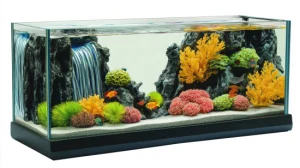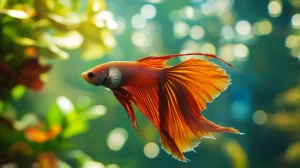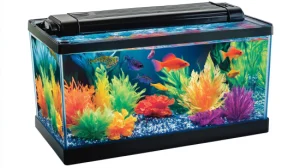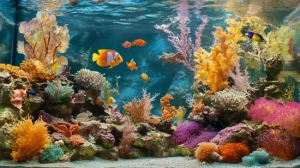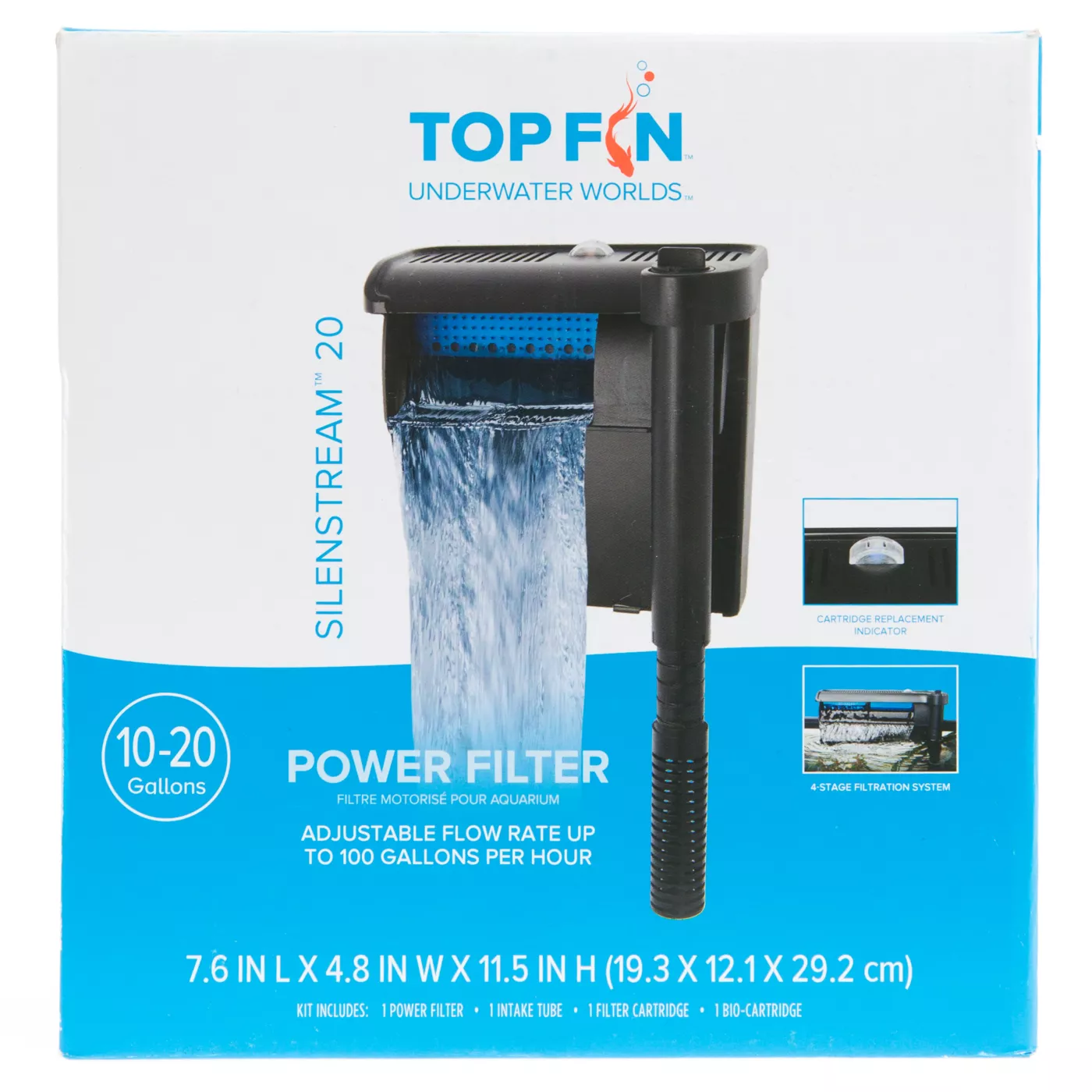
Top Fin® Silenstream™ Power Filter
- 3 Stage Filtration System
- Filters up to 300 gallons per hour
- Fresh & saltwater aquariums
$16.59
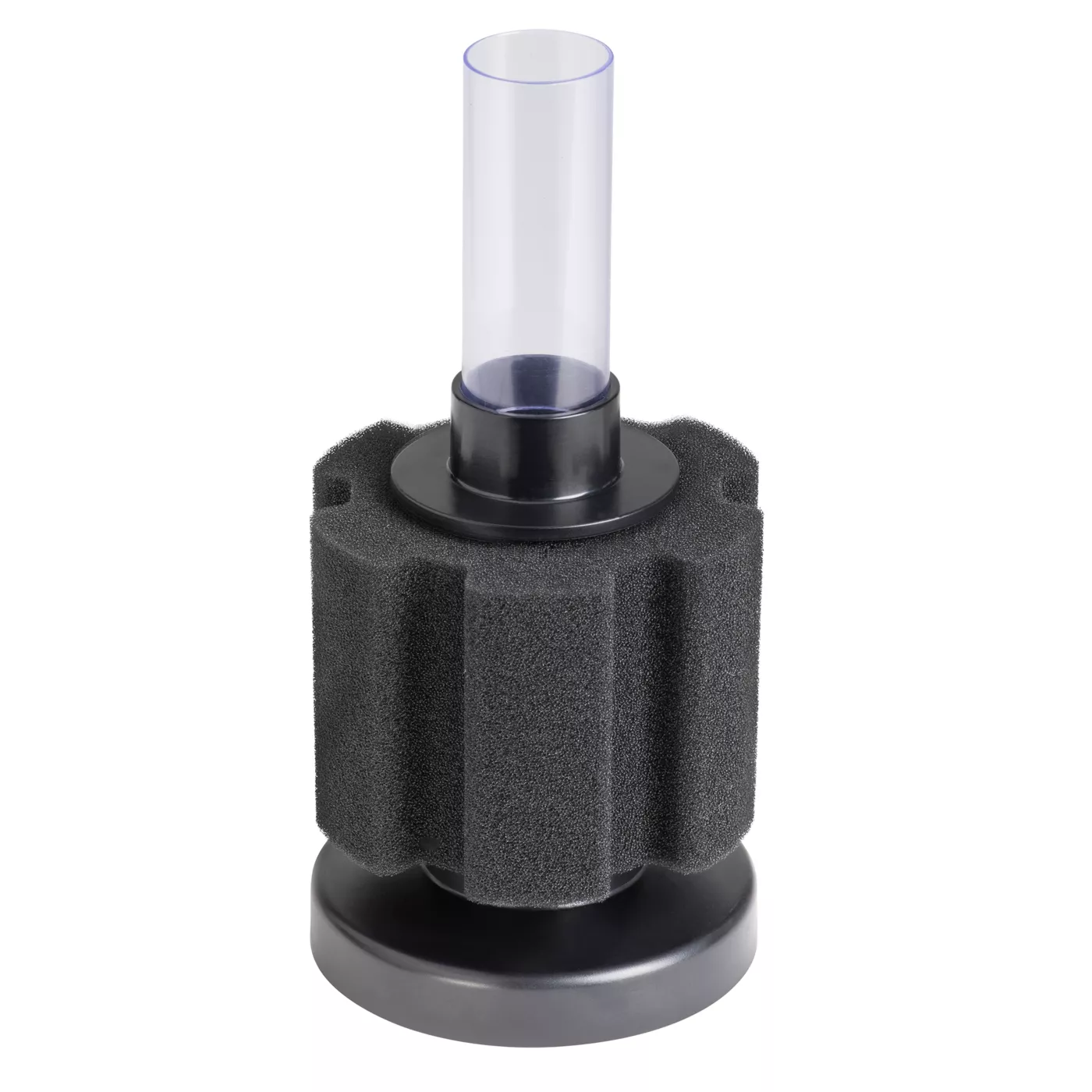
Top Fin® Sponge Filter
- Traps waste particles and improves water clarity
- Filters water without trapping small fish
- 2-stage filtration system
$6.19
Finding the perfect filter for your 20 gallon aquarium can be a challenging task. With so many options on the market, how do you know which one is right for your tank? After extensive research, I decided to go with the Top Fin 20 gallon filter – and I’m so glad I did!
In this blog post, I’ll share everything you need to know about selecting, setting up, and maintaining this fantastic filter. Whether you already own it or are considering buying it, you’ll learn tips for getting the most out of the Top Fin 20 gallon filter. Let’s dive in!
Why I Chose the Top Fin 20 Gallon Filter
I wanted a reliable, efficient filter that could handle the needs of my medium-sized freshwater community tank. Here’s what drew me to the Top Fin 20:
- Reputable brand – Top Fin is Petsmart’s proprietary brand and is known for quality and value. I trusted them to produce a good filter.
- Enough power – With an adjustable flow rate up to 200 GPH, I knew this filter would be strong enough to properly circulate and filtrate a 20 gallon tank.
- Multi-stage filtration – The Top Fin 20 uses mechanical, chemical, and biological filtration for clean, healthy water.
- Room for customization – This model has a versatile 3-stage filter design that accepts a variety of filter media. Perfect for customizing to your tank’s needs!
- Budget-friendly price – For a filter of this caliber, the Top Fin 20 is very reasonably priced. Much cheaper than comparable filters.
Setting Up the Top Fin 20 Gallon Filter
Installing and starting up the Top Fin 20 is straightforward, but here are some tips for smooth sailing:
- First, assemble all parts of the filter system according to the included directions. The intake tube, filter box, and adjustable outflow nozzle all fit together via simple connectors.
- Make sure the filter is unplugged before beginning set up to avoid motor damage.
- Rinse the filter media under cool tap water to remove any loose dust or debris. Never use soap when cleaning filter media! This will remove the beneficial bacteria.
- Place the bottom layer of biological filter balls or rings first. Then the activated carbon insert, followed by another layer of biological media. Top with the mesh pad.
- Hang the box on the back of your aquarium using the built-in hooks. Submerge the intake tube.
- Prime the filter by filling the box with aquarium water before plugging it in. This prevents the motor from burning out.
- Plug in and switch on the filter. Expect some gurgling noises at first as the system is purged of air.
- Adjust the outflow nozzle to disrupt the water surface without creating too much turbulence. Point it slightly upwards.
And that’s it – the Top Fin 20 is ready to operate! It should quickly blend into the aquarium background with its quiet, low-profile design.
Optimizing the Settings on Your Top Fin 20
One of the best things about the Top Fin 20 is the adjustable flow rate. This allows you to customize the filtration to meet your tank’s particular needs.
Here are some tips for fine-tuning the flow:
- Start low and increase gradually. You can always adjust the flow higher, but you don’t want to stress your fish with an overly strong current right away.
- For planted tanks, target 4-5 times the tank volume per hour. So for a 20 gallon tank, shoot for 80-100 GPH flow rate. This provides good water movement without buffeting delicate plants.
- If you have fish that prefer slower waters, keep the GPH lower. Bettas, dwarf cichlids, and tetras do best around 2-3 times tank volume turnover. For a 20 gallon, that’s 40-60 GPH.
- Monitor your fish carefully after adjusting flow rate. Make sure they aren’t showing signs of stress from too much current.
- Maintaining good mechanical filtration helps reduces the need for an intense flow rate. Change filter pads before they clog up.
- Check that outflow isn’t creating surface turbulence or pushing lower-swimming fish around. Diffuse flow with a spray bar if needed.
How Often Should You Change the Filter Cartridge?
The filter cartridge traps debris and contains chemical filter media for water polishing. But how frequently does it need to be changed?
For the Top Fin 20 gallon filter, I recommend:
- Swapping out the mechanical filter pad every 2-3 weeks. Soak used pads in bucket of tank water to dislodge gunk before discarding.
- Replacing the activated carbon bag once a month. Carbon absorbs impurities but stops working after 4-6 weeks.
- Only changing the ceramic bio rings/balls every 3-6 months. This is where beneficial bacteria colonize so you want to preserve that!
- If your tank is heavily stocked or you have super messy fish like goldfish or cichlids, perform filter maintenance on the more frequent end of those ranges.
- Always have a spare cartridge ready to swap out during maintenance! Never rinse cartridges under tap as it kills good bacteria.
Following this schedule will ensure your Top Fin filter is operating at peak performance. Adjust as needed based on your observations.
Step-By-Step Guide to Cleaning the Top Fin 20
To keep your Top Fin 20 running smoothly, it’s important to clean the system every few months. Here is a safe method:
Supplies Needed:
- Bucket of tank water
- Filter cartridge replacements
- Aquarium gravel cleaner
- Towels
Instructions:
- Unplug the filter first for safety. Disconnect all hoses.
- Bring the filter to a sink and open the chamber. Remove media baskets.
- Discard old filter cartridges. Do this away from the tank so gunk isn’t released into water.
- Rinse biological media like ceramic rings gently in the bucket of tank water only. Never use tap! This preserves beneficial bacteria.
- Wipe down inside filter box with damp towel. Avoid soap – it leaves behind chemical residue.
- Reassemble the baskets with new cartridges and biological media. Close up filter box.
- Reconnect hoses and hang filter back on tank. Re-prime before turning on.
- Plug in and power up filter. Check for leaks!
- Use gravel cleaner to vacuum substrate during water changes. This removes debris before it reaches filter.
And that’s it! Proper cleaning keeps the Top Fin 20 running at full filtering capacity.
Can the Top Fin 20 Gallon Filter Handle Saltwater Tanks?
No, the Top Fin 20 is designed for freshwater aquariums only. Using it on a saltwater or reef tank will cause problems:
- The flow rate is too low for proper water movement in a marine environment. Reef tanks need 10-20 times turnover per hour.
- Salt and protein will quickly clog up the filter cartridges and media. Biological filtration also requires different parameters.
- Coral debris can get caught in the intake strainer, damaging the impeller and motor.
- The activated carbon removes trace elements like iodine that saltwater creatures need.
- No protein skimmer means waste chemicals like nitrate accumulate to toxic levels for sensitive corals.
- Calcium and alkalinity are rapidly depleted without specialized filtration and routine dosing.
Instead of the Top Fin 20, I would recommend a quality canister filter paired with a protein skimmer for marine and reef setups. Shop for one rated for 3-4 times your tank volume to get the right flow rate and filtering capabilities. The investment will save you headaches down the road! Stick with basic hang-on-back models like the Top Fin 20 for freshwater only.
Troubleshooting Common Top Fin 20 Filter Problems
Like any piece of aquarium equipment, issues can pop up with the Top Fin 20 filter from time to time. Here’s how to diagnose and fix some common problems:
No Flow:
- Check that the filter is plugged in and switched on.
- Make sure the impeller spins freely and is not jammed.
- Clean out built-up gunk clogging the filter media or strainer.
- Check intake for obstructions or crimps in the tubing.
Leaking:
- Ensure all tubes and connections are properly seated in place.
- Replace any cracked filter box parts like cases or impellers.
- Lubricate the impeller shaft with aquarium-safe grease.
- Tighten down hose clamps if they are loose.
Excess Noise:
- Clear intake strainer and filter media of debris that could obstruct impeller.
- Fill filter box fully with water to prevent trickling noises.
- Check that media baskets and parts are snapped in correctly.
- Replace defective or grinding impeller.
Reduced Flow:
- Rinse filter media if clogged with gunk. Replace cartridges on schedule.
- Check intake and outflow for kinks or obstructions.
- Clean the impeller shaft of buildup slowing the motor.
By systematically troubleshooting issues piece by piece, you can get your Top Fin 20 running like new again quickly.
What is the Warranty on the Top Fin 20 Filter?
The Top Fin 20 filter comes with a generous and straightforward 1-year manufacturer’s warranty against defects and malfunctions.
This warranty is valid for one year from the original date of purchase. Make sure to keep your receipt!
If any parts fail or issues arise due to manufacturing faults during this year, PetSmart will replace the defective components at no charge. This includes defects like:
- Motor failures
- Broken impellers or shafts
- Leaky filter casings
- Malfunctioning flow valves
Normal wear and tear or damage from improper use is not covered. The warranty also does not include filter media like cartridges.
However, for the main filter components, it’s great peace of mind to have an entire year of coverage! Few companies offer such extensive warranties on affordable filters like this.
Just bring the faulty Top Fin 20 filter back to PetSmart along with your receipt. Their customer service team will handle swapping out the broken parts or providing a replacement. That way your filter will be back up and running smoothly!
How the Top Fin 20 Gallon Filter Compares to Other Brands
So how does the Top Fin 20 stack up against other popular filters on the market? Here’s a quick brand comparison:
- AquaClear: More customizable media options but higher price point
- Marineland: Decent performance and quality but louder
- Fluval: Very sleek but significantly more expensive for similar flow rates
- Penn Plax: Cheaper but flimsier construction overall
When looking at equivalent 20 gallon filters from other manufacturers, the Top Fin strikes the best balance of value, power, and ease of use.
The adjustable flow rate, self-priming design, quick-change cartridges, and quiet operation put it ahead of similarly priced competitors. Plus it comes with a generous 1 year warranty – longer coverage than almost any other entry-level filter.
While not as flashy looking as a Fluval or with quite as many bells and whistles as an AquaClear, the Top Fin 20 provides reliable, low-maintenance filtration at a very wallet-friendly price. For most hobbyists, it hits the filtering sweet spot without breaking the bank.
Can the Top Fin 20 Work on Bigger Aquariums?
Strictly following the product description, the Top Fin 20 is rated for tanks up to 20 gallons in volume. However, I have successfully used this filter on lightly stocked 30 gallon tanks with great results.
Here are some tips for safely using it on larger aquariums:
- Stay under 30 gallons max. This pushes the filter capacity but doesn’t overly strain it.
- Keep bio-load low. For a 30 gal, stick to 1 inch of small fish per gallon. Bigger fish or high densities will foul water.
- Supplement with extra aeration. An air stone or powerhead provides added oxygenation for bigger tanks.
- Maintain consistent filter maintenance. Stay on top of regular media changes to prevent flow reductions.
- Reduce lighting duration. This helps control waste production in larger tanks.
- Add extra biological media for more beneficial bacteria. Just watch flow rate impact.
- Monitor parameters closely. If ammonia or nitrates start creeping up, upgrade to a larger filter.
While I don’t recommend it long-term, the Top Fin 20 can temporarily work on tanks up to 30 gallons with the above precautions. This makes it a versatile option as your tank evolves over time!
Customizing Filter Media in the Top Fin 20
The Top Fin 20 comes ready to go with mechanical pads and activated carbon filter cartridges. However, one of its best features is the ability to customize the media to your needs!
Some popular filter media substitutions include:
- Extra biological – Bio balls, ceramic rings, or sintered glass like Fluval Biomax provide tons more surface area for beneficial bacteria. Great for heavily stocked or larger tanks.
- Filter floss – Very fine synthetic or natural fiber pads trap microscopic debris. Helps polish water to a crystal clear state.
- Peat granules – For soft, blackwater-like conditions. Use sparingly as it stains water.
- Crushed coral – Slowly raises pH and KH. Useful for African cichlid tanks that require hard, alkaline water.
- Phosphate removers – Chemical media that absorbs excess phosphates contributing to algae growth.
Just be mindful of flow rate reductions when adding lots of dense media. And never toss old media until new stuff is established! Follow safe cycling procedures to avoid mini-cycles. With the right mix, you can create your ideal filtration environment.
Where to Buy Replacement Parts and Accessories
The best place to find genuine Top Fin filter parts and accessories is right at your local PetSmart store. They stock all the components you need:
- Filter cartridges – Mechanical and chemical cartridges in various sizes to fit the 20 gallon filter. Sold individually or in value packs.
- Impellers – The rotating part that drives water through the filter. Eventually wears out and needs replacing.
- Intake tubes – Clear plastic intake pipes that pull water into the filter. Available in multiple lengths.
- Filter cases and covers – Replacement housings for the main filter assembly. Lids, cases, strainer baskets etc.
- Hose connectors and valves – Elbows, T valves, control valves and other plumbing parts to customize your setup.
- Filter media – Biological media like bio balls sold in bulk or mesh/floss sheets. Also chemical media.
Check out their online catalog for an full selection of replacement components. Purchase exactly what you need to keep your Top Fin filter running in tip top shape for years on end!
The Energy Efficiency of the Top Fin 20
One great benefit of hang-on-back filters like the Top Fin 20 is that they are very energy efficient. But exactly how much power do they use?
On average, a 20 gallon Top Fin filter will draw between 3-8 watts of electricity. This depends on what flow rate it is running at.
To put that in perspective:
- A traditional incandescent light bulb uses 60 watts.
- LED aquarium lighting uses around 1 watt per gallon.
- Larger canister filters can draw 20-40 watts.
So the power consumption of the Top Fin 20 is pretty miniscule! Even running it 24 hours a day would add just pennies onto your electric bill each month.
It’s not the most powerful filter out there, but the energy efficiency helps make up for that. You get solid filtration at a super low operating cost.
Plus, it doesn’t generate much heat and is near silent. All excellent bonuses that make it a very beginner-friendly filter option for your home aquarium. Give your wallet and ears a break!
What to Do if Your Top Fin 20 is Making Noise
Gurgling and trickling sounds are normal, but if your Top Fin 20 starts rattling, buzzing, or grinding, something is wrong! Here are some troubleshooting tips:
- Open it up and see if anything is obstructing the impeller inside. Remove debris.
- Check that the impeller turns and spins freely. Remove and clean if needed. Replace if damaged.
- Make sure all filter media and parts are stacked properly in their baskets and trays.
- Fill the filter completely with water to stop air bubbles causing trickling noises.
- Lubricate the impeller shaft and o-ring with aquarium-safe lubricant to stop grinding.
- Check intake and output for anything blocking steady water flow.
- Listen closely to isolate the noise, then replace the problematic part. Motors, covers, impellers etc.
- Add foam media or an external pump muffler to help dampen vibrations and buzzing.
Excess noise usually means something isn’t moving smoothly inside the filter or water flow is being disrupted. Take the time to diagnosis the specific issue, and you can get back to quiet operation in no time.
What Reviews Say About the Top Fin 20 Gallon Filter
Curious what fellow fishkeepers think of the Top Fin 20? Overall reviews are quite positive, with most users giving it between 4 and 5 stars. Here are some of the most common pros and cons mentioned:
Pros
- Reliable, consistent performance
- Very quiet compared to other HOB filters
- Easy to set up and maintain
- Clear instructions
- Good value for money
- Adjustable flow rate
- Works great for the price
Cons
- Cartridges are expensive and don’t last long
- Can vibrate and shake if not properly leveled
- Flow rate may be too low for larger or saltwater tanks
- Motor may burn out after 1-2 years with heavy use
- Can’t customize media as much as premium brands
In general, reviewers find the Top Fin 20 performs very solidly for smaller freshwater tanks at an affordable price point. The biggest complaints relate to cartridge costs and limited media customization. But overall, it earns praise as a quiet, user-friendly filter that gets the job done!
Reducing Vibration in Your Top Fin 20
It’s frustrating when your quiet filter suddenly turns into a buzzing machine! Here are some tips to minimize vibration from the Top Fin 20:
- Level the filter evenly on the tank rim to prevent rocking and shaking. Use shims if needed.
- Separate it from hard surfaces with foam pads so vibration isn’t amplified.
- Fill the filter box fully with water according to the manual to stop gurgling.
- Tighten all tubes and connections so water flows smoothly without gushing.
- Clean internal parts like the impeller regularly to prevent imbalance.
- Install a spray bar on the output to distribute flow and reduce pulsing.
- Weigh down tubes so they don’t rattle against the tank. Use suction cups.
- Replace worn parts like motors that have become noisy.
- Add dense foam media which helps absorb energy and dampen vibrations.
With a few simple adjustments, you can go from a shaky, buzzing filter back to the peace and quiet of normal operation.
Installing the Top Fin 20: Step-by-Step Guide
Installing the Top Fin 20 filter takes less than 10 minutes if you follow these easy steps:
Supplies Needed:
- Top Fin 20 filter
- Aquarium water
- Filter cartridges
Directions:
- Rinse filter media under tap to remove dust. Never use soap.
- Attach the intake tube, filter box, and adjustable outflow tube. Push together firmly.
- Stack filter cartridges inside the media trays in the correct order: mechanical, chemical, biological.
- Fill box with aquarium water before plugging in to prime the pump. This is crucial!
- Hang the filter on the back of the tank using built-in hooks. Submerge intake tube.
- Plug into GFCI outlet and switch on power. Expect gurgling at first.
- Adjust outflow nozzle rate and angle – point slightly upward to create surface agitation.
- Observe flow pattern and make any adjustments needed. Done!
See, very quick and easy! Just be methodical, avoid leaks, and properly prime before starting. Then sit back and let your new Top Fin 20 do its job filtering and clarifying the tank.
Caring for Your Top Fin 20: Maintenance Tips
To keep your Top Fin 20 running smoothly for years, follow this maintenance routine:
- Every 2 weeks – Swap out mechanical filter pads when they appear dirty.
- Monthly – Replace chemical filtration cartridges.
- Every 2-3 months – Rinse biological media like bio balls in old tank water only during water changes. Replenish over time.
- Every 6 months – Take apart filter, clean inside walls and impeller shaft, lube parts.
- Annually – Replace impeller to prevent premature breakdown.
- As needed – Clean intake strainer of debris buildup blocking water flow.
Following this schedule prevents little issues from cascading into bigger problems down the road! With regular care, a Top Fin 20 can operate reliably for 5+ years.
What is the Lifespan of the Top Fin 20?
As one of the most affordable and entry-level hang-on-back filters, the Top Fin 20 is designed to be very user-friendly and accessible. However, the more budget-minded construction does impact the overall lifespan.
With consistent maintenance and proper care, most Top Fin 20 filters continue running smoothly for 2-3 years on average.
The flow rate and performance may start to decline after the 1 year mark as parts like the impeller wear down with use. But complete breakdown is unlikely before hitting the 2-3 year mark, even with continual operation.
To maximize the lifespan of your Top Fin 20:
- Change mechanical/chemical media on schedule to maintain flow.
- Every 6 months, disassemble and clean/lube internal parts.
- Rinse/replace biological media during maintenance to prevent fouling.
- Replace impeller annually for optimal motor function.
- Avoid running on overstocked/oversized tanks continuously.
- Ensure proper intake strainer cleaning.
- Don’t disturb beneficial bacteria colonies.
- Follow electrical safety with a GFCI outlet.
With some extra care, a Top Fin 20 can keep filtering past the 3 year mark. But due to affordability constraints, its lifespan is more limited than higher-end brands. Plan accordingly!
Why the Top Fin 20 is My Filter of Choice for Small Tanks
After reading this complete guide, it should be clear why I’m such a fan of the Top Fin 20 gallon filter! To summarize, here are the key benefits that make it my top pick for 10-20 gallon freshwater aquariums:
- Trusted brand with a reputation for quality and value
- Adjustable flow rate to customize for any tank inhabitants and setup
- Whisper-quiet operation that blends into the background
- Easy maintenance with simple media replacement
- Reliable mechanical, chemical, and biological filtration for crystal clear water
- Room to add supplementary filter media for enhanced biological or chemical removal
- Minimal energy consumption for efficient 24/7 use
- 1 year warranty providing peace of mind
- Very reasonably priced making it accessible for any hobbyist budget
For small freshwater tanks, the Top Fin 20 can’t be beat! It provides everything needed for healthy, clean water at a fraction of the cost of higher-end filters. If you’re just starting out or want an affordable workhorse filter, the Top Fin 20 is absolutely my top recommendation.

